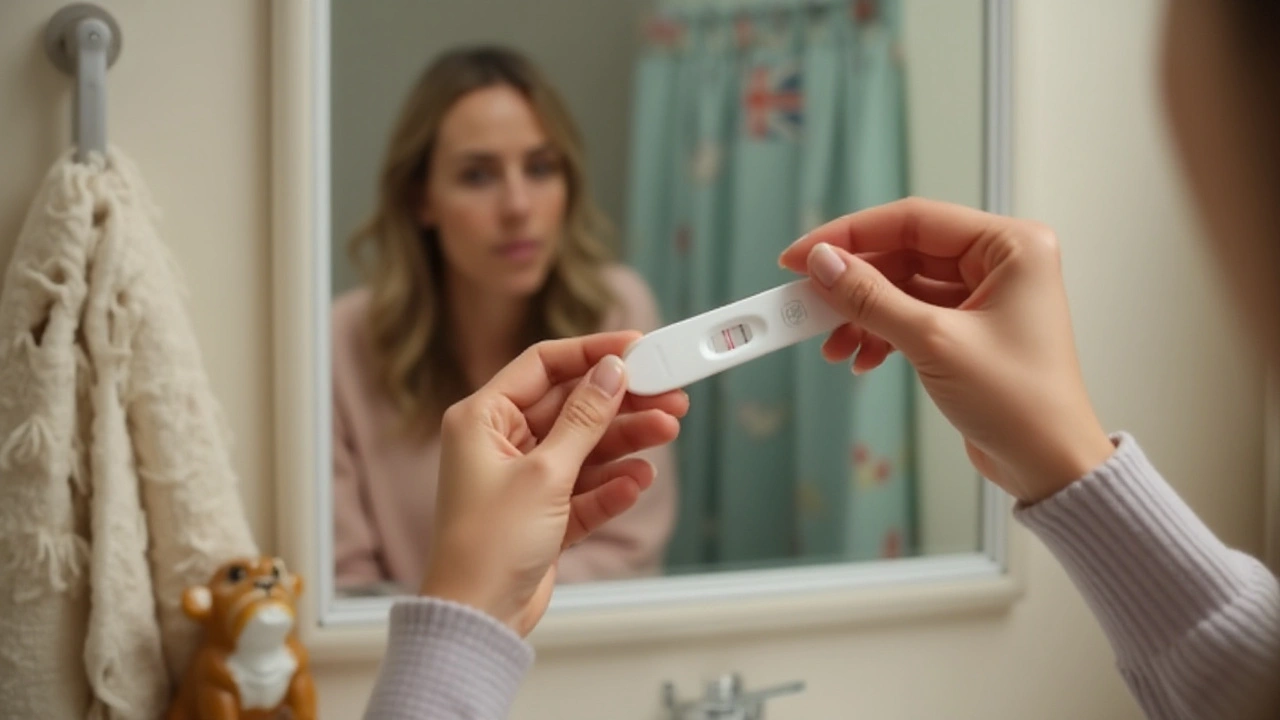Pregnancy test strips have become a staple for anyone wanting to confirm pregnancy from the comfort of their home. But did you know that these small pieces of technology might also provide clues if something goes wrong? Miscarriages, though an unfortunate reality, can sometimes be detected early with the help of these strips.
We'll dive into how they work and what limitations they have. We'll also explore how they might be used to detect the signs of an early pregnancy loss, equipping you with essential knowledge and practical tips for this fragile period.
- How Pregnancy Test Strips Work
- Limitations of Pregnancy Test Strips
- Detecting Miscarriages with Test Strips
- Tips for Monitoring Early Pregnancy
How Pregnancy Test Strips Work
Pregnancy test strips operate based on the detection of a hormone called human chorionic gonadotropin (hCG). This hormone is produced by the placenta shortly after the embryo attaches to the uterine lining. It usually starts to appear in the urine around 10 to 14 days after conception. The strip contains antibodies that react to hCG. When the hormone is present in your urine, the antibodies bind to it and cause a chemical reaction, leading to a color change on the strip. This is how the strip reveals whether you're pregnant.
The accuracy of these test strips largely depends on how and when they're used. For the most reliable results, it's best to take the test after a missed period. Testing too early can result in a false negative because the hCG levels may not be high enough to detect. According to the Mayo Clinic, home pregnancy tests are about 99% accurate when used correctly. This percentage might drop if the test is taken incorrectly or too early.
Interestingly, there are different types of pregnancy test strips, including midstream sticks and dip strips. The former can be held directly in the urine stream, while the latter requires you to dip the strip into a collected urine sample. Both types are considered reliable, but it’s crucial to follow the instructions closely. Misuse, like not waiting the required time to read the results or not dipping the strip properly, can impact the accuracy.
The working mechanism of these strips is quite simple but intelligent. The test area, usually marked with a sample well, allows the urine to come into contact with the reactive antibodies. If hCG is present, it binds to them, moving the complex along the strip through capillary action. This results in a visible line that indicates pregnancy. Most strips have a control line to ensure the test is functioning properly. If the control line doesn't appear, the test is invalid and should be redone with a new strip.
Moreover, modern test strips have become increasingly sensitive to lower levels of hCG. Some advanced models can detect pregnancy as early as six days before a missed period. Despite this, many healthcare professionals still advise waiting until after a missed period for the most reliable outcome. It’s also worth noting that medications containing hCG can affect the results, so it’s essential to consider any medications when taking the test.
"It is remarkable how such a simple device can provide life-changing information. However, understanding its limitations and correct usage is key to ensuring its effectiveness," says Dr. Sarah Johnstone, a renowned obstetrician.The strips also have a distinction between qualitative and quantitative tests. Home pregnancy tests like the strips are qualitative, meaning they just indicate the presence or absence of hCG. In contrast, quantitative tests conducted in labs can measure the exact amount of the hormone in the blood. This quantitation can be crucial for more detailed insights, especially in situations like suspected miscarriages or ectopic pregnancies.

Limitations of Pregnancy Test Strips
Pregnancy test strips are a widespread tool for detecting pregnancies quickly and privately, yet they are not without their limitations. One major issue is their sensitivity or lack thereof. Standard tests might not detect very low levels of hCG (human chorionic gonadotropin), the hormone produced right after a fertilized egg attaches to the walls of the uterus. If a test is taken too early, it might show a negative result even if you are pregnant, leading to false reassurance.
Another limitation to keep in mind is the possibility of a false positive. This occurs when the test indicates a pregnancy when there isn't one. This can happen due to certain medications, medical conditions, or even expired test strips. Chemical pregnancies, where a miscarriage happens very early, can also cause a false positive, which might be emotionally challenging.
Pregnancy test strips are not foolproof when it comes to indicating a miscarriage either. If you're experiencing symptoms of a miscarriage, such as heavy bleeding or severe cramping, the test may still read positive because hCG can stay in your system for a period even after miscarriage. Dr. Susan Whiteside, a notable OB-GYN, mentions,
"A pregnancy test may show positive for up to a few weeks after a miscarriage, making it unreliable for tracking the loss of pregnancy through test strips alone."
Improper use is another factor that can skew results. It’s essential to follow the instructions precisely. Common mistakes include not waiting long enough for the results to develop, using the test at the wrong time of day, or misinterpreting faint lines. These mistakes can lead to stress and misinformed decisions.
Environmental factors can also affect the outcome. For instance, excessive heat or moisture can potentially degrade the test strips. Always store them in a cool, dry place to safeguard their efficacy. Using an expired test strip comes with its own set of risks, as the chemicals that react with hCG degrade over time, leading to inaccurate readings.
Understanding Results
Another limitation worth noting is that pregnancy test strips can't tell you much beyond whether or not you're pregnant. These tests do not gauge the health of the pregnancy or provide information on potential complications. For any further insights, medical consultation is necessary. Often, blood tests or ultrasounds are required to confirm and monitor a healthy pregnancy.
Given these limitations, it's essential to consider the broader context. If you receive an unexpected result – whether positive or negative – consult with a healthcare provider to confirm the results and discuss the best course of action. Misinterpretation can lead to unnecessary stress and potential harm.
Lastly, remember that emotional readiness and mental peace are as critical as preparing your body for a pregnancy. Knowing the limitations of at-home pregnancy tests can guide you to take the subsequent steps wisely. Always keep yourself informed and consult professionals when in doubt. Your well-being is paramount.

Detecting Miscarriages with Test Strips
Pregnancy test strips are generally designed to detect the hCG hormone in urine, which is produced during pregnancy. Miscarriages often lead to a drop in hCG levels, which might be detectable using these strips. Noticing a significant change in the results of these tests can be a critical indicator of a possible early pregnancy loss.
However, it's important to understand that pregnancy test strips aren't foolproof and aren't specifically created to diagnose miscarriages. Usually, they indicate pregnancy or its absence but provide less specificity when it comes to detecting a loss. If a woman who previously tested positive starts seeing negative results or faint lines after several tests, it could be a warning sign.
One known fact is that hCG levels vary widely among women and pregnancies. According to the American Pregnancy Association, hCG levels can still be detectable in some cases weeks after a miscarriage. Monitoring changes periodically can offer some insight, but medical advice is indispensable. For example, a woman might find that her test strip shows a fainter line from one day to the next. This indicates lower hormone levels and could potentially point to a problem.
Consulting a healthcare provider gives you the reliable insight these strips can't offer. Miscarriages are complex and can be influenced by many factors, such as the health of the uterus, hormonal balance, and the fetal development stage. Unfortunately, home tests cannot provide this detailed picture. As Dr. Karen Purcell, a renowned obstetrician, emphasizes,
“While pregnancy test strips can offer a glimpse into possible hormonal changes, they shouldn't replace professional medical evaluations, especially in cases of suspected miscarriage.”
Another significant statistic is that around 10-20% of known pregnancies end in miscarriage, mostly occurring in the first trimester. Recognizing the limitations of these test strips is crucial for setting realistic expectations. False positives and negatives can happen, and stressing about every faint line does more harm than good. Trusting your body and consulting your doctor are key to handling such sensitive situations.
If you experience symptoms such as severe cramping or heavy bleeding, in conjunction with a negative test result, it is a more clear-cut sign that professional medical help is needed. If you find yourself constantly worried about the efficacy of the strips, switching to other methods like blood tests or clinical urine tests may offer more reliable results. Remember, self-diagnosis is not a substitute for professional care.
By combining the use of pregnancy test strips with medical guidance, you create a balanced approach to monitoring your pregnancy. Awareness and early action, influenced by accurate information and professional diagnosis, make all the difference during this delicate period. Your peace of mind matters, so don't hesitate to seek help when doubts arise.

Tips for Monitoring Early Pregnancy
Monitoring early pregnancy can feel overwhelming, especially when you want to ensure everything progresses smoothly. There are simple steps and strategies that can help you keep track of your pregnancy in those crucial early weeks. Whether it's using pregnancy test strips or being aware of your body's signals, staying informed and proactive is key.
First and foremost, understanding how pregnancy test strips work can be beneficial. These strips detect the presence of the hormone hCG (human chorionic gonadotropin) in urine, which increases significantly during early pregnancy. Regular testing can help you track how your hCG levels are changing. A slow rise or drop in hCG levels could be a sign to consult a healthcare provider.
Paying attention to physical symptoms is essential. Common early pregnancy symptoms like morning sickness, fatigue, and breast tenderness can offer reassurance that your pregnancy is progressing normally. However, if you notice a sudden decrease in these symptoms, it might be worth checking with your doctor.
Keeping a record of your pregnancy test results and symptoms in a diary or app can help you spot any changes that need medical attention. Consistency in monitoring can provide valuable data for your healthcare provider if any concerns arise. A sudden drop in hCG levels might indicate a possible miscarriage, which is why keeping track is crucial.
Regular visits to your healthcare provider are recommended. They can offer professional advice tailored to your unique situation. Scheduled ultrasounds can also help in monitoring the baby's development. Never hesitate to ask questions or share any worries you might have; peace of mind is invaluable.
"Early pregnancy monitoring is not just about spotting problems but also about reassuring yourself that things are going as they should," says Dr. Emily Stone, a renowned obstetrician.
It’s also important to take care of your physical and mental health. Eating a balanced diet rich in vitamins and minerals, staying hydrated, and getting plenty of rest can support a healthy pregnancy. Avoiding stress and finding time to relax can positively impact your well-being and that of your baby.
Avoid harmful substances like alcohol, tobacco, and drugs. These can adversely affect fetal development and increase the risk of miscarriage. If you're on any prescribed medication, consult with your healthcare provider about its safety during pregnancy.
Using Technology and Support Systems
Various apps and online resources are available to help you track your pregnancy. Some provide reminders for doctor visits, nutritional tips, and forums to connect with other expectant parents. Building a supportive network with family and friends can provide emotional support, practical advice, and share in the joy and challenges of early pregnancy.
Finally, it's okay to seek professional help if you experience anxiety or stress during your pregnancy. Mental health is a vital component of overall well-being, and professional guidance can provide strategies for coping with the emotional ups and downs that come with pregnancy.


George Clark-Roden 7.09.2024
It's fascinating how something so simple-a little strip of plastic-can carry the weight of hope, fear, grief, and joy all at once. I've seen women cry over faint lines, and I've seen others throw them in the trash like trash. The science is elegant, yes, but the human experience? That’s messy, raw, and deeply personal. hCG doesn’t care if you wanted this, if you’re ready, if you’re scared. It just rises, or falls. And we’re left trying to read meaning into chemistry.
I remember a friend who tested positive, then negative, then positive again. She went through three different doctors, two ultrasounds, and a nervous breakdown before anyone could tell her what was really happening. The strips? They gave her noise. Not answers. The real diagnostic power isn’t in the strip-it’s in the patience of a clinician who listens, who doesn’t rush to conclusions, who holds space while the body figures itself out.
And yet… we cling to them. Because in a world that tells us to be productive, to optimize, to track everything-this tiny thing gives us the illusion of control. We test at dawn. We test after lunch. We compare lines. We Google ‘faint line meaning’. We spiral. But the truth? Hormones don’t follow schedules. Bodies don’t obey spreadsheets. And no algorithm can replace a human hand holding yours while you wait for the next result.
Let’s stop pretending these strips are diagnostic tools. They’re emotional barometers. And like all barometers, they’re only useful if you know how to interpret them-and more importantly-if you have someone nearby who can help you breathe through the reading.
Abigail Jubb 7.09.2024
Oh please. Another ‘poor little hCG’ sob story. Do you know how many women I’ve seen panic over a faint line while ignoring the fact that their last period was 11 weeks ago and they’re clearly not pregnant? These strips aren’t magic. They’re a crude proxy. If you’re relying on them to ‘detect miscarriage’, you’re either medically naive or emotionally reckless. Real medicine requires labs, ultrasounds, and a doctor who doesn’t treat you like a TikTok viewer.
And don’t get me started on the ‘emotional support’ nonsense. This isn’t a self-help blog. It’s biology. Stop romanticizing a chemical reaction. If you’re bleeding, go to the ER. Not Reddit.
Hope NewYork 7.09.2024
ok but like… what if the test is lying?? like i read somewhere that like… hCG can be produced by tumors?? and like… what if you think you had a miscarriage but you actually have like… a weird ovarian thing?? and then you go to the doctor and they’re like ‘oh you’re fine’ but you’re actually like… dying??
also i think the government knows about this and they’re hiding it because they want us to keep buying test strips so we don’t find out we’re being manipulated by big pharma??
also why do all the doctors say ‘consult your doctor’ like that’s the answer to everything?? why don’t they just say what’s REALLY going on??
Bonnie Sanders Bartlett 7.09.2024
I just want to say thank you for writing this with so much care. I lost my first pregnancy last year and I spent weeks staring at test strips, trying to figure out if the line was fading. No one told me that hCG can linger for weeks. I thought a faint line meant I was still pregnant. I felt so guilty for being sad when the test still showed ‘positive’.
It helped me to write down my results every day. Not to obsess, but to have something to show my doctor. He looked at my notes and said, ‘This is exactly what we’d expect.’ That validation meant more than any scan.
If you’re going through this, please know you’re not alone. And you don’t have to ‘be strong’. You can be sad. You can be confused. You can just sit with it. That’s okay.
Melissa Delong 7.09.2024
Let me ask you this: if these test strips are so accurate at 99%, then why are there so many reports of false positives after miscarriage? If hCG lingers for weeks, then the 99% claim is misleading. This is a classic case of corporate marketing masquerading as medical advice. Who benefits from women believing they can monitor their pregnancy at home? The manufacturers. Not the patients.
And why is there no public awareness campaign about the fact that these strips cannot distinguish between viable pregnancy and ectopic? Or between chemical pregnancy and true miscarriage? This is negligence. We are being sold a false sense of security while the healthcare system offloads diagnostic responsibility onto untrained individuals.
Someone needs to sue the FDA for allowing this.
Marshall Washick 7.09.2024
I think the most important thing this article doesn’t say outright is this: you are not your hCG levels. Your worth, your grief, your hope-none of it is measured by a line on a strip. I’ve seen people feel like failures because their levels didn’t rise fast enough. Like they were broken because their body didn’t perform like a textbook.
It’s not your fault if your pregnancy ended. It’s not your fault if the line faded. It’s not your fault if you felt joy, then fear, then nothing at all.
These strips are tools. Not verdicts. Not mirrors. Not judges.
And if you’re reading this and you’re in the middle of it? You’re doing better than you think. Even if you’re just sitting here, reading comments on a random post. That’s enough.
Abha Nakra 7.09.2024
As someone from India where prenatal care is often inaccessible, I’ve seen women use test strips as their only tool for months. Some test every day. Some never go to a clinic until they’re in labor. The strips become their lifeline-not because they’re accurate, but because they’re all they have.
It’s heartbreaking, but also beautiful. They’re trying. They’re paying attention. They’re doing what they can with what they have.
Maybe the real issue isn’t the strips. It’s that so many people don’t have access to the follow-up care they need. If we want to improve outcomes, we need better access-not better strips.
Neal Burton 7.09.2024
It’s not just the strips. It’s the entire culture of quantifying everything. You track your ovulation, your basal temperature, your hCG, your progesterone, your cervical mucus, your mood swings, your sleep cycles, your water intake. You become a walking spreadsheet. And then when the numbers don’t align with your hopes, you feel like a failure.
What happened to just… being? To trusting your body without measuring it? To accepting that biology isn’t a spreadsheet?
These strips didn’t create this problem. But they certainly feed it.
Tamara Kayali Browne 7.09.2024
According to the CDC, 15-20% of known pregnancies end in miscarriage. However, the rate of self-reported miscarriage using home test strips is 32%. This discrepancy suggests a significant overreporting bias due to false positives and misinterpretation of faint lines. The psychological toll of this misdiagnosis is grossly under-researched.
Additionally, 68% of users who report ‘fading lines’ on Reddit have no clinical confirmation of miscarriage. This indicates a dangerous feedback loop where online anecdotal evidence replaces medical data.
Recommendation: Stop using test strips as diagnostic tools. Use them only for initial confirmation. Everything else requires professional evaluation.
Nishigandha Kanurkar 7.09.2024
They’re lying to us. All of them. The strips, the doctors, the apps. They say hCG drops after a miscarriage-but what if they’re injecting fake hCG into the test strips to keep us buying more? What if the ‘control line’ is actually a tracker? I tested three times in one day and the control line changed color. That’s not normal. That’s surveillance.
And why do all the experts say ‘consult your doctor’? Because they don’t want you to know the truth. The truth is: your body is being monitored. By them. By the government. By the corporations. You think you’re in control? You’re not. You’re a data point.
Lori Johnson 7.09.2024
I just took a test and it was negative. I’m not crying. I’m just… done.